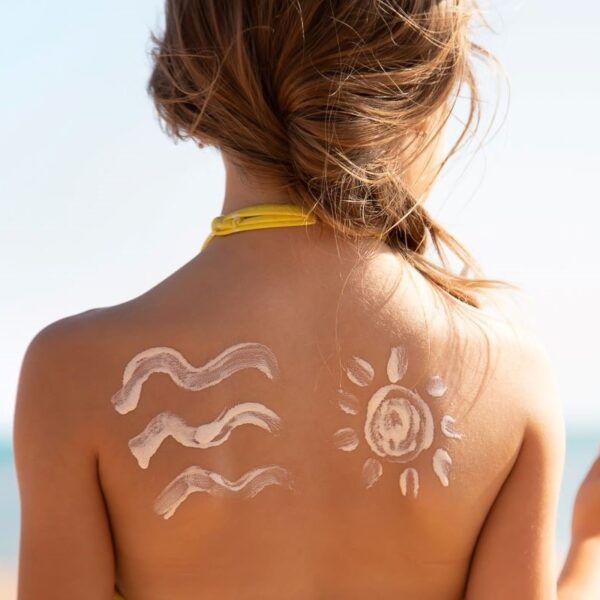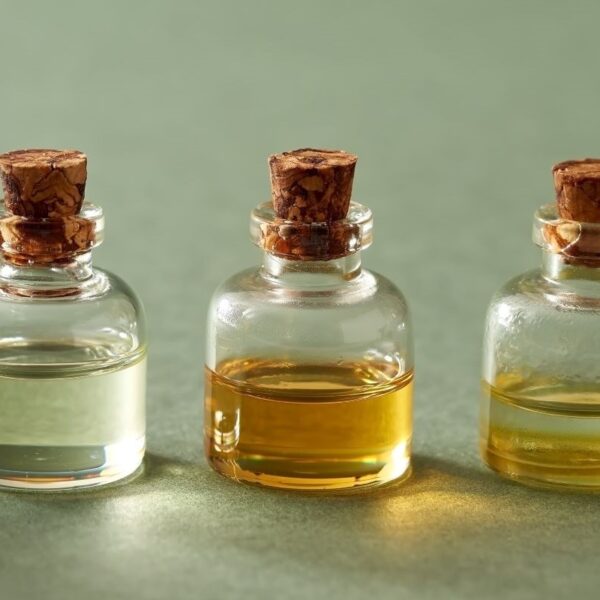Cetearyl alcohol is a mixture of stearyl alcohol and cetyl alcohol that can come from vegetable or synthetic sources. The mixture forms a waxy, white substance used in cosmetics and personal care products to smooth and thicken the product while adding hydrating properties. Unlike other alcohols, which tend to make skin more dry, cetearyl alcohol traps water and treats skin dryness.
What is Cetearyl Alcohol?
Cetearyl alcohol is a white, waxy solid, usually sold in a flake form. It consists primarily of a combination of cetyl (hexadecanol) and stearyl (octadecanol) alcohols. Cetearyl alcohol is also known as cetostearyl alcohol and cetyl/stearyl alcohol. It is insoluble in water and soluble in alcohol and oils.
Source: Wikipedia
The ratio of stearyl and cetyl alcohol varies in cetearyl alcohol. Technical grade cetearyl alcohol contains approximately 65-80% stearyl and 20-35% cetyl alcohol. Though cetearyl alcohol consists mainly of cetyl and stearyl alcohols, small quantities of alcohols with longer and shorter chain lengths are usually present in this mixture.
How is Cetearyl Alcohol Produced?
Cetearyl alcohol is a solid organic compound that can be isolated from fats. Cetyl alcohol is synthetically manufactured by reducing ethyl palmitate with metallic sodium and alcohol or under acidic conditions with lithium aluminum hydride as a catalyst.
Use of Cetearyl Alcohol in Cosmetics & Personal Care Products
Cetearyl alcohol is used in various moisturizers and skin lotions for binding ingredients together. Additionally, because it effectively moisturizes and relieves dry skin, it’s commonly used in skincare and hair care products such as shampoos, conditioners, and anti-frizz hair creams.
Applications in Cosmetics and Personal Care Products
| Function | Applications |
| Emollient | Cetearyl alcohol is an emollient that can be used in water-in-oil emulsions, oil-in-water emulsions, and anhydrous formulations. It gives the skin and hair a soft feel and adds body to creams and lotions. |
| Emulsifying | Cetearyl alcohol emulsifies immiscible liquids by modifying the interfacial tension (water and oil). |
| Emulsion Stabilizer | Cetearyl alcohol helps product formulas to maintain texture, consistency, and thickness. |
| Opacifying Agent | Cetearyl alcohol acts as an opacifier that provides a rich, creamy, luxurious feel and appearance to formulations. It prevents light transmission and adds brightness and whiteness to the end product. It has excellent formulation compatibility and stability. |
| Surfactant | Cetearyl alcohol is a non-ionic surfactant that helps boost foam in a formulation and improves the efficacy of cleansers. |
| Viscosity Controller | Cetearyl alcohol improves the viscosity of creams, lotions, cleansers, and shower/bath products. |
| Foam Booster | Cetearyl alcohol improves the quality of the foam produced by increasing one or more of the following properties: volume, texture, and stability. |
Product Examples
| Type | Examples |
| Skincare | Face Creams, Moisturizing Lotions, Barrier Creams |
| Bath & Body Care | Body Wash, Bar Soaps, Exfoliants |
| Hair Care | Hair Color, Temporary Hair Coloring Products, Hairspray |
Properties of Cetearyl Alcohol
| Appearance at 25 °C | Pastilles or liquid |
| Molecular Weight (g/mol) | 260 |
| Density at 18°C (g/cm3) | 1.0117 |
| Viscosity (25 °C) | 53 cP |
| Solubility | Freely soluble in ethyl ether, chloroform. Soluble in petrol ether and ethyl alcohol. Practically insoluble in water, paraffin oil. |
| Melting Point °C (50.5 °F; 283.4 K) | 50°C |
| Boiling Point °C (338 °F; 443 K) | 249°C |
| Odor | Odorless |
| Shelf Life | 24 months |
| Storage Conditions | Store in a cool, dry place in original sealed containers, protected from moisture. Ideal Storage Temperature: <40°C |
Typical Formulations
Body Therapy: Cleansing Bar for Hair & Body
The following cleansing bars clean and soothe the body and hair.
- Beauté by Roquette® SA 130: Purifying skin and scalp
- Beauté by Roquette® LS 007: Reducing the use of listed preservatives
| PHASE | INCI Name | TRADE Name | Supplier | % Wt. |
| A | Cetearyl Alcohol | Lanette O | BASF | 30 |
| Hydrogenated Vegetable Oil | Cegesoft HF 62 | BASF | 5 | |
| Cetearyl Alcohol, Lecithin, Sodium Cetearyl Sulfate, Vegetable Oil | Plantaquat NC | BASF | 10 | |
| Sodium Lauryl Sulfate | Texapon K12G | BASF | 33 | |
| Benzyl Alcohol | Microcare® BNA | Thor | 0.4 | |
| B | Aqua | Demineralized water | – | 9 |
| Cocamidopropyl Betaine | Dehyton PK 45 | BASF | 5 | |
| Sorbitol | Beauté by Roquette® PO 070 | Roquette® | 2.60 | |
| Gluconolactone | Beauté by Roquette® GA 290 | Roquette® | 1 | |
| Succinic Acid | Beauté by Roquette® SA 130 | Roquette® | 1 | |
| Gluconic Acid, Caprylyl/capryl Glucoside, Cymbopogon Citratus Leaf Extract | Beauté by Roquette® LS 007 | Roquette® | 1 | |
| C | Cyclodextrin | Beauté by Roquette® CD 100 | Roquette® | 2 |
| Total: | 100 | |||
Formulation Procedure
- Prepare phase A at 70°C in a separate beaker.
- At 70°C, add phase B into phase A under gentle to medium agitation. Keep agitation and temperature consistent for 10 minutes.
- At 70°C, add phase C.
- Pour into packaging at 60-65°C.
Specifications
Aspect: Off-white to light yellow solid bar.
Stability: 1 month at 50°C and three months at room temperature or 40°C.
Source: Knowde
Cetearyl Alcohol Formulation Considerations
- For skincare products, adding cetearyl alcohol results in luxurious, rich formulas, reducing potential stickiness from oil and butter and creating smooth, light, moisturizing products.
- In hair care, cetearyl alcohol increases spreadability and slip, allowing products to glide through hair.
- Because cetearyl alcohol is commonly used as a co-emulsifier and thickener to help stabilize the emulsion, it should be used to supplement the oil phase by reducing the amount of heavy emollients and improving the texture of products. Substituting a percentage of the butter in a formula with cetearyl alcohol can give the moisturizer a pleasant skin feel while maintaining its body and texture.
- Cetearyl alcohol is suitable for a wide pH range with ideal usage guidelines from 1% to 3%. It should be added in the heated oil phase stage of the formulation.
Source: Good Formulations
Safety & Regulatory Considerations
| FDA Information | When derived from plants, cetearyl alcohol may be used in cosmetics and personal care products marketed in Europe according to the general provisions of the Cosmetics Regulation of the European Union. Ingredients of animal origin must comply with European Union animal by-products regulations. |
| EU Information | When derived from plants, cetearyl alcohol may be used in cosmetics and personal care products marketed in Europe according to the general provisions of the Cosmetics Regulation of the European Union.Ingredients of animal origin must comply with European Union animal by-products regulations. |
| Cosmetic Ingredient Review (CIR) Information | The safety of cetearyl alcohol has been assessed by the Cosmetic Ingredient Review (CIR) Expert Panel. The panel evaluated the scientific data and concluded that these fatty alcohols were safe for use as cosmetic ingredients. |
Health Effects of Cetearyl Alcohol
- Cetearyl alcohol is a safe and non-toxic ingredient that poses little to no risk when applied to the skin and hair. However, a patch test is recommended because rash formation has been known to occur when applied in certain concentrations on highly sensitive skin. This ingredient is also biodegradable and does not pose any known environmental hazard. Additionally, plant-based derivatives make cetearyl alcohol halal and vegan.
- Cetearyl alcohol was found to have no significant toxicity and was non-mutagenic.
- According to the FDA Trusted Source, even cosmetic products labeled “alcohol-free” are allowed to contain cetearyl alcohol and other fatty alcohols. Cetearyl alcohol is also on the FDA’s list of safe and permitted food additives.
- Clinical skin irritation and sensitization studies of product formulations containing cetearyl alcohol showed no signs of skin irritation or sensitization following the dermal application of 3% cetearyl alcohol. Based on the available data included in the report, it is concluded that cetearyl alcohol is safe as a cosmetic ingredient in the present practices of use.
- The ocular irritation potential of a cream containing 3.0% cetearyl alcohol was assessed in 9 albino rabbits. A one-tenth milliliter of the product was instilled into one eye of each animal. The eyes of three animals were rinsed 30 sets after instillation. Ocular reactions were scored at 1, 2, 3, 4, and 7 days post-instillation. The product was classified as a nonirritant.
Identification Numbers
| CAS Number | 67762-27-0 |
| EC Number | 267-008-6 |
Acceptable Limits or Maximum Usage
The maximum usage level of cetearyl alcohol in cosmetics and personal care products as per CIR is as follows.
| Category | Usage Level |
| Hair Conditioners | 1-5% |
| Hair Straightener | 1-5% |
| Hair Rinse, Shampoo (Coloring/Non-Coloring) | 0.1-1% |
| Bath Soaps And Detergents | 1-5% |
| Shaving Creams (Aerosol, Brushless, and Lather) | 0.1-1% |
| Skin Cleansing Preparation (Cold Creams, Lotions, Liquid) | 0.1-5% |
| Moisturizing Skin Care Preparation | 1-25% |
| Eye Make Up Product | 1-5% |
| Face Mask (Mud Mask) | 1-10% |
| After Shave Lotion | 0.1-1% |
| Makeup Foundation | 0.1-1% |
| Face, Body, Hand, and Skin Care Preparation (Excluding Shaving Preparation) | 1-5% |
Source: CIR
Fun Facts About Cetearyl Alcohol
- Due to its many desirable properties, cetearyl alcohol is found in some pharmaceutical preparations.
- The sourcing of palm oil, a common source of cetearyl alcohol, has raised environmental concerns due to deforestation and habitat destruction. Some manufacturers are working to use sustainably sourced ingredients or find alternatives to address these issues.
Additional Resources
- CIR Safety | Final Report on the Safety Assessment of Cetearyl Alcohol
- ECHA | Registered Dossier Information on a Specific Substance
- Healthline | Uses and Information on Cetearyl Alcohol
- Cosmetics Info | Ingredient Profile: Cetyl Alcohol
- Good Formulations | Benefits of Cetearyl Alcohol in Skincare Products









